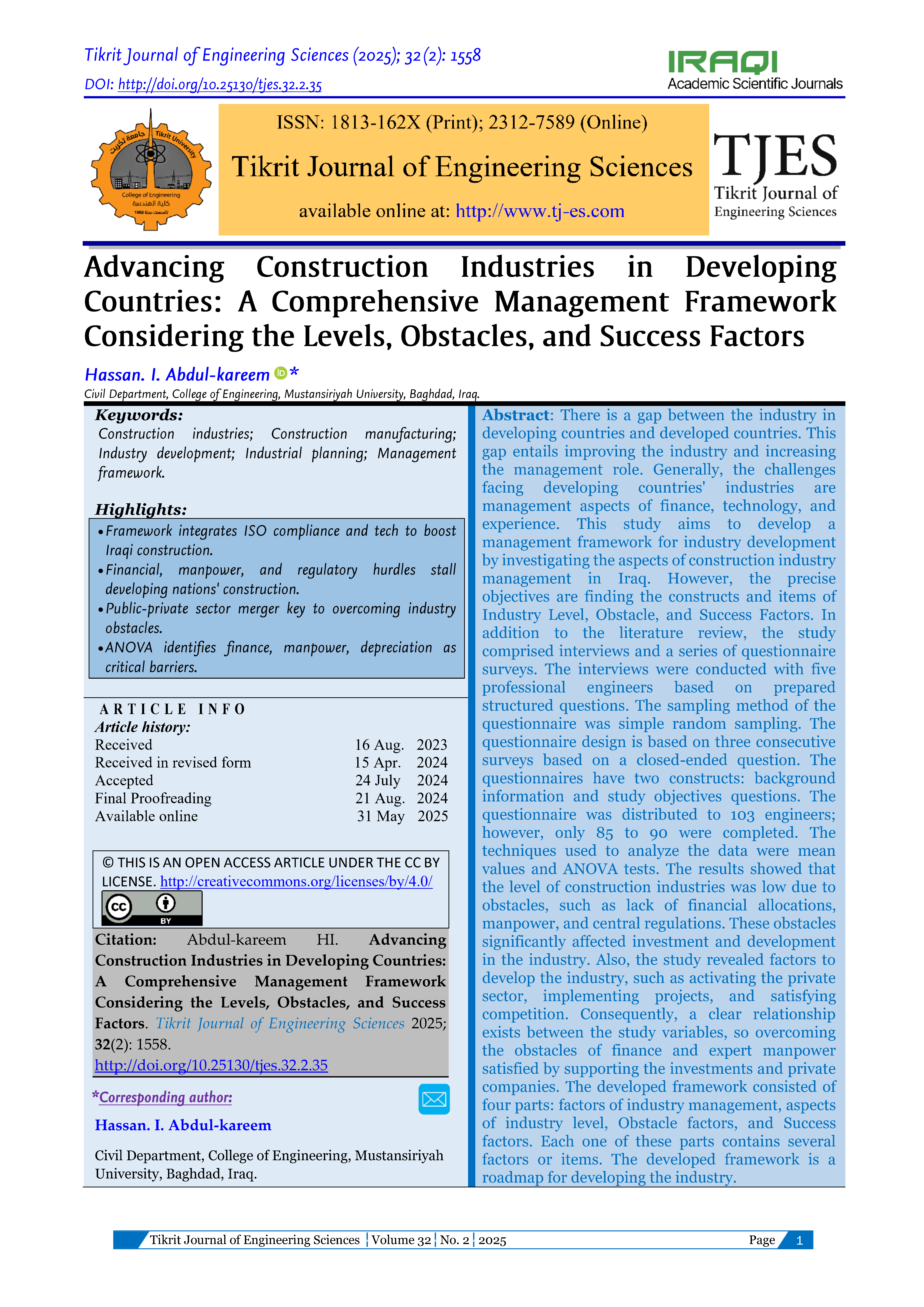Advancing Construction Industries in Developing Countries: A Comprehensive Management Framework Considering the Levels, Obstacles, and Success Factors
Main Article Content
Abstract
There is a gap between the industry in developing countries and developed countries. This gap entails improving the industry and increasing the management role. Generally, the challenges facing developing countries' industries are management aspects of finance, technology, and experience. This study aims to develop a management framework for industry development by investigating the aspects of construction industry management in Iraq. However, the precise objectives are finding the constructs and items of Industry Level, Obstacle, and Success Factors. In addition to the literature review, the study comprised interviews and a series of questionnaire surveys. The interviews were conducted with five professional engineers based on prepared structured questions. The sampling method of the questionnaire was simple random sampling. The questionnaire design is based on three consecutive surveys based on a closed-ended question. The questionnaires have two constructs: background information and study objectives questions. The questionnaire was distributed to 103 engineers; however, only 85 to 90 were completed. The techniques used to analyze the data were mean values and ANOVA tests. The results showed that the level of construction industries was low due to obstacles, such as lack of financial allocations, manpower, and central regulations. These obstacles significantly affected investment and development in the industry. Also, the study revealed factors to develop the industry, such as activating the private sector, implementing projects, and satisfying competition. Consequently, a clear relationship exists between the study variables, so overcoming the obstacles of finance and expert manpower satisfied by supporting the investments and private companies. The developed framework consisted of four parts: factors of industry management, aspects of industry level, Obstacle factors, and Success factors. Each one of these parts contains several factors or items. The developed framework is a roadmap for developing the industry.
Metrics
Article Details

This work is licensed under a Creative Commons Attribution 4.0 International License.
THIS IS AN OPEN ACCESS ARTICLE UNDER THE CC BY LICENSE http://creativecommons.org/licenses/by/4.0/
Plaudit
References
Yang F, Gu S. Industry 4.0, a Revolution that Requires Technology and National Strategies. Complex & Intelligent Systems 2021; 7(3):1311-1325. DOI: https://doi.org/10.1007/s40747-020-00267-9
Ofori G. Challenges of Construction Industries in Developing Countries: Lessons from Various Countries. Singapore: Department of Building, National University of Singapore; 2002.
Richard DM, William AP, Shih J. Jobs Versus the Environment: An Industry-Level Perspective. Washington: Resources for the Future; 2000.
Haag S, Cummings M. Management Information Systems for the Information Age. 8th ed., New York: McGraw-Hill; 2010.
Laudon KC, Laudon JP. Essentials of Management Information Systems. 9th ed. London: Pearson Education; 2011.
Robbins SP, Judge TA. Essentials of Organizational Behavior. 11th ed. London: Pearson Education; 2011.
Karimli D. Conceptual Framework for the Strategic Management. International Journal of Management & Development 2020; 7(10):144-149. DOI: https://doi.org/10.19085/sijmd071001
Lawrence WR, Boris E, Kilian G. The Direction of Industry: A Literature Review on Industry 4.0. International Conference on Engineering Design 2019:2129-2138. DOI: https://doi.org/10.1017/dsi.2019.219
Budler M, Trkman P. The Nature of Management Frameworks. Journal of Management & Organization 2023; 29(2):173-190. DOI: https://doi.org/10.1017/jmo.2019.83
McKeown T. Examining Management Buzzwords - Starting with Creativity and Innovation. Journal of Management & Organization 2019; 25(1):1-3. DOI: https://doi.org/10.1017/jmo.2019.2
Minniti M. Entrepreneurship and Network Externalities. Journal of Economic Behavior & Organization 2005; 57(1):1-27. DOI: https://doi.org/10.1016/j.jebo.2004.10.002
Al-Musawi L, Naimi S. The Management of Construction Projects in Iraq and the Most Important Reasons for the Delay. International Scientific Journal about Logistics 2023; 10(1):61-70. DOI: https://doi.org/10.22306/al.v10i1.351
Li Y. Industrial Development Report 2018: Demand for Manufacturing - Driving Inclusive and Sustainable Industrial Development. Vienna: UNIDO; 2017.
Maroof Z, Hussain S, Jawad M, Naz M. Determinants of Industrial Development: A Panel Analysis of South Asian Economies. Quality & Quantity 2019; 53(15):1391-1419. DOI: https://doi.org/10.1007/s11135-018-0820-8
Li Y. Industrial Development Report 2020: Industrializing in the Digital Age. Vienna: UNIDO; 2019.
Tronvoll B, Sklyar A, Sörhammar D, Kowalkowski C. Transformational Shifts Through Digital Servitization. Industrial Marketing Management 2020; 89(6):293-305. DOI: https://doi.org/10.1016/j.indmarman.2020.02.005
Construction Products Association. Construction Industry Forecasts 2022-2024. London: CPA; 2022:1-105.
Bentley LD, Whitten JL. Systems Analysis & Design for the Global Enterprise. 2nd ed. New York: McGraw-Hill; 2007.
Jones GR, Hill CWL. Theory of Strategic Management with Cases. 10th ed. Mason: Cengage Learning; 2013.
Waters D. Operations Management. Boston: Addison-Wesley; 1996.
Al-Mhdawi MKS, Brito M, Onggo BS, Qazi A, O'Connor A. COVID-19 Emerging Risk Assessment for the Construction Industry of Developing Countries: Evidence from Iraq. International Journal of Construction Management 2023; 24(7):693-706. DOI: https://doi.org/10.1080/15623599.2023.2169301
Abramov L, Alzaidi ZA. Assessing of Sustainable Construction Quality in Iraq under Conditions of Risk Factors. 3rd International Conference for Civil Engineering Science 2023:1-12. DOI: https://doi.org/10.1088/1755-1315/1232/1/012041
Battaïa O, Dolgui A, Heragu SS, Meerkov SM, Tiwari MK. Design for Manufacturing and Assembly/Disassembly: Joint Design of Products and Production Systems. International Journal of Production Research 2018; 56(24):7181-7189. DOI: https://doi.org/10.1080/00207543.2018.1549795
World Bank Group. Global Economic Prospects. Washington: World Bank; 2022:1-176.
Construction Industry Development Board. Industrialised Building System (IBS) Assessment & Certification. Kuala Lumpur: CIDB; 2023:1-19.
Denzin NK, Lincoln YS. The Sage Handbook of Qualitative Research. 3rd ed. Thousand Oaks: Sage Publications; 2005.
Al-Saeed Y, Edwards DJ, Scaysbrook S. Automating Construction Manufacturing Procedures Using BIM Digital Objects (BDOs): Case Study of Knowledge Transfer Partnership Project in UK. Construction Innovation 2020; 20(3):345-377. DOI: https://doi.org/10.1108/CI-12-2019-0141
Sekaran U. Research Methods for Business. 4th ed. Hoboken: Wiley; 2003.
Dey MK. Turnover and Return in Global Stock Markets. Emerging Markets Review 2005; 10(6):45-67. DOI: https://doi.org/10.1016/j.ememar.2004.09.003
Abdul-Kareem HI, Abu Bakar AH. Management Procedures for Realizing Information Technology Benefits in Malaysia. International Journal of Construction Management 2013; 13(3):1-13. DOI: https://doi.org/10.1080/15623599.2013.10773213
Pallant J. SPSS Survival Manual: A Step by Step Guide to Data Analysis Using SPSS for Windows. 10th ed. Maidenhead: Open University Press; 2001.





